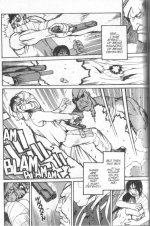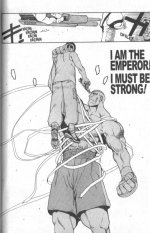
UDON’s Super Street Fighter: New Generation Fights Like Gentlemen
February 17th, 2013 Posted by GavokThat title isn’t even grammatically– you know what? Forget it.
The Street Fighter franchise has always given us interesting comics to work with. When the second game hit the scene and became an early-90’s phenomenon, we got both a terrible series in America that got canceled by the third issue and a manga that made enough sense out of the few existing story beats and created something entertaining. Various manga would appear throughout the years, becoming so beloved by Capcom that they’d introduce characters and concepts as being canon in the games, such as Sagat’s adopted children and Sakura’s rival Karin.
Starting in 2003, UDON – known mainly for that badass redesign of the Taskmaster back in the day that nearly every artist has chosen to foolishly ignore – began a Street Fighter series. While the constantly-changing and cropping titles makes it a headache at times to keep track of, it’s a fun narrative that tries to streamline the many characters and happenings in the game’s universe. Mainly written by Ken Siu-Chong, the comics have told the stories of Street Fighter, the Street Fighter Alpha games and Street Fighter II while doing side stories to build on the cast of Street Fighter III and Street Fighter IV. All that and miniseries based on Chun-Li, Sakura and Ibuki. Sadly, Adon is yet to get his own series.
The end of the Street Fighter II: Turbo series doesn’t quite stick the landing due to the reveal in Street Fighter IV that Gouken – Ryu and Ken’s master – isn’t so dead after all. Incorporating him into the final issue is not unlike having Thomas Wayne show up to punch out the Joker in the climax of a lengthy Batman story. Once that was done, UDON stayed silent for a while until announcing that their Street Fighter comics would no longer be monthlies, but released in graphic novel format. The first of which is Super Street Fighter: New Generation.

More than the format, what really makes this new story different for Siu-Chong is the pre-existing definition. Capcom has defined much of the events of the earlier Street Fighter games and what became of who, so the previous comics were Siu-Chong connecting the dots with his own little touch. New Generation is based on the Street Fighter III games (which storywise is comprised of Street Fighter III: Second Impact and Street Fighter III: Third Strike), which lack all that narrative detail. The games introduced an overwhelmingly new cast with only Ryu and Ken returning, eventually bringing in Akuma and Chun-Li for familiarity. Capcom never went out and came up with too many canon descriptions of what went on in the storyline.
The book tells its own version of the events of Street Fighter III, but with the inclusions of characters from previous games. Heck, Guile is our main character and he wasn’t even in any version of Street Fighter III. It’s neat to see explanations of what became of certain people from the pre-III games. For instance, after Bison’s death and Sagat’s refusal to have anything to do with the criminal enterprise, Shadaloo’s resources were divvied up by Balrog and Vega, who each went legit. Sakura graduated high school and became Ryu’s student, all while wearing an even more gratuitously fanservicey outfit (she’s now Ryu without pants). Zangief, Mike Haggar and Rainbow Mika became members of the Olympic council, making the recent real world situation with wrestling being dropped kind of hilarious in the timing.
The main story deals with the Secret Society, a cult run by the ever-powerful, thong-wearing, two-toned nutjob Gill. Guile – who has spent the last four years at a desk job since the fall of Shadaloo – is investigating the situation, but is alarmed when his inside man has gone missing. Even worse, he finds out of an unfinished list of targets that the cult is after and everyone’s favorite karate Jedi Ryu is on top of the list. Worser than that, Guile’s already too late and he discovers that Ryu’s already been taken. Worse-worsier, he finds this out through Sakura, who’s been driven insane from the experience and demands that Guile stay out of her way. To uncover the mystery, Guile is joined by angry military grappler Alex and another world warrior who I won’t spoil.
That’s not the whole package. Scattered throughout are chapters that tell side-stories. Wrestler Mania with art by Gonzalo Ordonez Arias shows how an argument between E. Honda and Hakan over which wrestling style should be added into the Olympics becomes a full-on fight. Target. Dhalsim. with art from Andres S. Blanco has Twelve attack Dhalsim in the Himalayas while morphing into various characters from the first game. Final Forest Fighter II by Jim Zub and Sean Galloway shows a sparring match between ninjas Guy and Ibuki. There’s also origin stories for Alex (Long Vo on art) and Juri (Zub on words, Omar Dogan on art) with the latter one being especially good. At the very least, it explains why Juri could be so vengeful against Bison/Shadaloo while being a full-on villain with no redeeming values.
Oh, I almost forgot. America’s sweetheart Chris Sims teams up with Edwin Huang to write School in the Summertime, a six-page story where brash, powerhouse boxer Balrog crosses paths with refined fisticuffs gentleman Dudley. It definitely hits its potential and as luck would have it, UDON released the full thing on Facebook. That keeps my conscious clean enough to post them here.








“…gutter trash.”
The hardcover also features a bunch of pages of character art. It retails at $34.95, but you’re better off hitting Amazon or BN.com for a better deal. If you’ve enjoyed the previous comics or have always wanted to read a story about an overly-happy Turkish man who loves oiling himself up more than anyone ever should, it’s worth checking out. Just not at list price.
Now if only UDON would allow me to write an Adon backup. He’s basically just Chris Jericho, but with more kicking. What’s not to love?





















